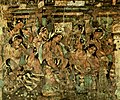History of erotic depictions
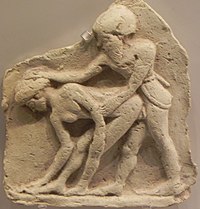

The history of erotic depictions includes paintings, sculpture, photographs, dramatic arts, music and writings that show scenes of a sexual nature throughout time. They have been created by nearly every civilization, ancient and modern. Early cultures often associated the sexual act with supernatural forces and thus their religion is intertwined with such depictions. In Asian countries such as India, Nepal, Sri Lanka, Japan and China, representations of sex and erotic art have specific spiritual meanings within native religions. The ancient Greeks and Romans produced much art and decoration of an erotic nature, much of it integrated with their religious beliefs and cultural practices.[1][2]
In more recent times, as communication technologies evolved, each new technique, such as printing, photography, motion pictures and computers, has been adapted to display and disseminate these depictions.[3]
Attitudes through history

In early times, erotic depictions were often a subset of the indigenous or religious art of cultures and as such were not set aside or treated differently than any other type. The modern concept of pornography did not exist until the Victorian era. Its current definition was added in the 1860s, replacing the older one meaning writings about prostitutes.[6] It first appeared in an English medical dictionary in 1857 defined as "a description of prostitutes or of prostitution, as a matter of public hygiene."[7] By 1864, the first version of the modern definition had appeared in Webster's Dictionary: "licentious painting employed to decorate the walls of rooms sacred to bacchanalian orgies, examples of which exist in Pompeii."[8] This was the beginning of what today refers to explicit pictures in general. Though some specific sex acts were regulated or prohibited by earlier laws, merely looking at objects or images depicting them was not outlawed in any country until 1857. In some cases, the possession of certain books, engravings or image collections was outlawed, but the trend to compose laws that actually restricted viewing sexually explicit things in general was a Victorian construct.[3]
When large-scale
Pornography has existed throughout recorded history and has adapted to each new medium, including photography, cinema, video, and computers and the internet.
The first instances of modern pornography date back to the sixteenth century when sexually explicit images differentiated itself from traditional sexual representations in European art by combining the traditionally explicit representation of sex and the moral norms of those times.[10]
The first amendment prohibits the U.S. government from restricting speech based on its content. Indecent speech is protected and may be regulated, but not banned. Obscenity is the judicially recognized exception to the first amendment. Historically, this exception was used in an attempt to ban information about sex education, studies on nudism, and sexually explicit literature.[11]
In the case of People v. Freeman, the California Supreme Court ruled to distinguish prostitution as an individual taking part in sexual activities in exchange for money versus an individual who is portraying a sexual act on-screen as part of their acting performance.[12] The case was not appealed to the U.S. Supreme Court, thus it is only binding in the state of California.[13]
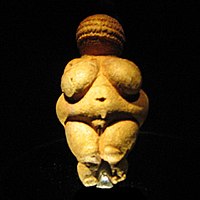
Early depictions
Prehistoric
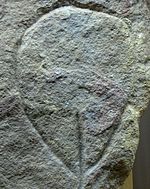
Among the oldest surviving examples of erotic depictions are
Archaeologists in Germany reported in April 2005 that they had found what they believe is a 7,200-year-old scene depicting a male figurine bending over a female figurine in a manner suggestive of sexual intercourse. The male figure has been named Adonis von Zschernitz.[16]
Mesopotamia
A vast number of artifacts have been discovered from ancient Mesopotamia depicting explicit sexual intercourse.[17][18] Glyptic art from the Sumerian Early Dynastic Period frequently shows scenes of frontal sex in the missionary position.[17] In Mesopotamian votive plaques from the early second millennium BC, the man is usually shown entering the woman from behind while she bends over, drinking beer through a straw.[17] Middle Assyrian lead votive figurines often represent the man standing and penetrating the woman as she rests on top of an altar.[17] Scholars have traditionally interpreted all these depictions as scenes of ritual sex,[17] but they are more likely to be associated with the cult of Inanna, the goddess of sex and prostitution.[17] Many sexually explicit images were found in the temple of Inanna at Assur,[17] which also contained models of male and female sexual organs,[17] including stone phalli, which may have been worn around the neck as an amulet or used to decorate cult statues,[17] and clay models of the female vulva.[17]
Egypt
Depictions of sexual intercourse were not part of the general repertory of ancient Egyptian formal art,
Greek and Roman


The
There are numerous sexually explicit paintings and sculptures from the ruined Roman buildings in
Peruvian

The
Rafael Larco Hoyle speculates that their purpose was very different from that of other early cultures. He states that the Moche believed that the world of the dead was the exact opposite of the world of the living. Therefore, for funeral offerings, they made vessels showing sex acts such as masturbation, fellatio and anal sex that would not result in offspring. The hope was that in the world of the dead, they would take on their opposite meaning and result in fertility. The erotic pottery of the Moche is depicted in Hoyle's book Checan.[27]
Asia
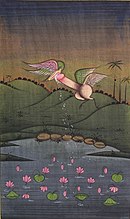
There has been a long tradition of erotic painting in the East.
In Japan, erotic art found its widest success in the medium of
The Chinese tradition of erotic art was also extensive, with examples dating back as far as the Yuan dynasty (1271–1368). The erotic art of China reached its peak during the latter part of the Ming dynasty (1368–1644).[1][29]
In both China and Japan, eroticism played a prominent role in the development of the novel.
Arabic and Islamic
The
, and has a section on the interpretation of dreams. Interspersed with these there are a number of stories which are intended to give context and amusement.
European
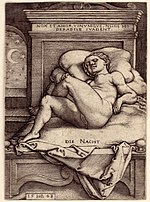
Erotic scenes in
It was not until the invention of the
Beginnings of mass circulation
Printing
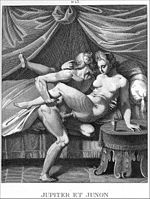
Prints became very popular in Europe from the middle of the fifteenth century, and because of their compact nature, were very suitable for erotic depictions that did not need to be permanently on display. Nudity and the revival of classical subjects were associated from very early on in the history of the print.
Many prints of subjects from mythological subjects were clearly in part an excuse for erotic material; the engravings of Giovanni Battista Palumba in particular. An earthier eroticism is seen in a printing plate of 1475–1500 for an Allegory of Copulation where a young couple are having sex, with the woman's legs high in the air, at one end of a bench, while at the other end a huge penis, with legs and wings and a bell tied around the bottom of the glans, is climbing onto the bench. Although the plate has been used until worn out, then re-engraved and heavily used again, none of the contemporary impressions printed, which probably ran into the hundreds, have survived.[36]
The loves of classical gods, especially those of
In around 1524 - 1527 the artist Marcantonio Raimondi published I Modi. I modi contained engravings of sexual scenes and was created in a collaboration between Marcantonio raimondi and Giulio Romano. One idea is that Raimondi based the engravings on a series of erotic paintings that Giulio Romano was doing as a commission for the Palazzo del Te in Mantua. Pope Clement VII destroyed all copies of the engravings. Romano did not know of the engravings until Pietro Aretino, considered a founder of pornography,[39][40] came to see the original paintings while Romano was still working on them. Aretino then composed sixteen explicit sonnets ("both in your cunt and your behind, my prick will make me happy, and you happy and blissful")[3][41] to go with the paintings. I Modi was then published a second time in 1527, with the poems and the pictures, making this the first time erotic text and images were combined, though the papacy once more seized all the copies it could find. There are now no known copies of the first two editions of "I modi" by Marcantonio Raimondi and Giulio Romano. The text in existence is only a copy of a copy that was discovered 400 years later.[3][41] In around 1530 Agostino Veneziano is thought to have created a replacement set of engravings for those that were in I modi.
In the 17th century, numerous examples of pornographic or erotic literature began to circulate. These included L'Ecole des Filles, a French work printed in 1655 that is considered to be the beginning of pornography in France. It consists of an illustrated dialogue between two women, a 16-year-old and her more worldly cousin, and their explicit discussions about sex. The author remains anonymous to this day, though a few suspected authors served light prison sentences for supposed authorship of the work.[42] In his famous diary, Samuel Pepys records purchasing a copy for solitary reading and then burning it so that it would not be discovered by his wife; "the idle roguish book, L'escholle de filles; which I have bought in plain binding… because I resolve, as soon as I have read it, to burn it."[43]
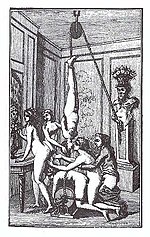
During the
The English answer to the French was Memoirs of a Woman of Pleasure (later abridged and renamed Fanny Hill), written in 1748 by John Cleland. While the text satirised the literary conventions and fashionable manners of 18th century England, it was more scandalous for depicting a woman, the narrator, enjoying and even reveling in sexual acts with no dire moral or physical consequences. The text is hardly explicit as Cleland wrote the entire book using euphemisms for sex acts and body parts, employing 50 different ones just for the term penis. Two small earthquakes were credited to the book by the Bishop of London and Cleland was arrested and briefly imprisoned, but Fanny Hill continued to be published and is one of the most reprinted books in the English language. However, it was not legal to own this book in the United States until 1963 and in the United Kingdom until 1970.[46]
Photography

In 1839, Louis Daguerre presented the first practical process of photography to the French Academy of Sciences.[47] Unlike earlier photographic methods, his daguerreotypes had stunning quality and detail and did not fade with time. Artists adopted the new technology as a new way to depict the nude form, which in practice was the feminine form. In so doing, at least initially, they tried to follow the styles and traditions of the art form. Traditionally, an académie was a nude study done by a painter to master the female (or male) form. Each had to be registered with the French government and approved or they could not be sold. Soon, nude photographs were being registered as académie and marketed as aids to painters. However, the realism of a photograph as opposed to the idealism of a painting made many of these intrinsically erotic.[3]
The daguerreotypes were not without drawbacks, however. The main difficulty was that they could only be reproduced by photographing the original picture since each image was an original and the all-metal process does not use
In 1841,
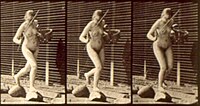
The Victorian pornographic tradition in the UK had three main elements: French photographs, erotic prints (sold in shops in Holywell Street, a long vanished London thoroughfare, swept away by the
Magazines
During the Victorian period, illegal pornographic periodicals such as The Pearl, which ran for eighteen issues between 1879 and 1880, circulated clandestinely among circles of elite urban gentlemen.[52] In 1880, halftone printing was used to reproduce photographs inexpensively for the first time.[47] The invention of halftone printing took pornography and erotica in new directions at the beginning of the 20th century. The new printing processes allowed photographic images to be reproduced easily in black and white, whereas printers were previously limited to engravings, woodcuts and line cuts for illustrations.[53] This was the first format that allowed pornography to become a mass market phenomena, it now being more affordable and more easily acquired than any previous form.[3]
First appearing in France, the new magazines featured nude (often, burlesque actresses were hired as models) and semi-nude photographs on the cover and throughout; while these would now be termed softcore, they were quite shocking for the time. The publications soon either masqueraded as "art magazines" or publications celebrating the new cult of naturism, with titles such as Photo Bits, Body in Art, Figure Photography, Nude Living and Modern Art for Men.[3] Health and Efficiency, started in 1900, was a typical naturist magazine in Britain.[54]
Another early form of pornography were comic books known as Tijuana bibles that began appearing in the U.S. in the 1920s and lasted until the publishing of glossy colour men's magazines commenced. These were crude hand drawn scenes often using popular characters from cartoons and culture.[55]
In the 1940s, the word "
In postwar Britain digest magazines such as Beautiful Britons, Spick and Span, with their interest in nylons and underwear and the racier Kamera published by Harrison Marks were incredibly popular. The creative force behind Kamera was Harrison Marks' partner Pamela Green. These magazines featured nude or semi-nude women in extremely coy or flirtatious poses with no hint of pubic hair.
Penthouse, started by Bob Guccione in England in 1965, took a different approach. Women looked indirectly at the camera, as if they were going about their private idylls. This change of emphasis was influential in erotic depictions of women. Penthouse was also the first magazine to publish pictures that included pubic hair and full frontal nudity, both of which were considered beyond the bounds of the erotic and in the realm of pornography at the time. In the late 1960s, magazines began to move into more explicit displays often focusing on the buttocks as standards of what could be legally depicted and what readers wanted to see changed. By the 1970s, they were focusing on the pubic area and eventually, by the 1990s, featured sexual penetration, lesbianism and homosexuality, group sex, masturbation, and fetishes in the more hard-core magazines such as Hustler.[3][56]
Magazines for every taste and fetish were soon created due to the low cost of producing them. Magazines for the gay community flourished, the most notable and one of the first being Physique Pictorial, started in 1951 by Bob Mizer when his attempt to sell the services of male models; however, Athletic Model Guild photographs of them failed. It was published in black and white, in a very clear yet photographic manner celebrating the male form and was published for nearly 50 years. The magazine was innovative in its use of props and costumes to depict the now standard gay icons like cowboys, gladiators and sailors.[3][57]
Moving pictures

Production of erotic films commenced almost immediately after the invention of the motion picture. Two of the earliest pioneers were Frenchmen
Also in 1896 Fatima's Coochie-Coochie Dance
Because Pirou is nearly unknown as a pornographic filmmaker, credit is often given to other films for being the first. In Black and White and Blue (2008), one of the most scholarly attempts to document the origins of the clandestine 'stag film' trade, Dave Thompson recounts ample evidence that such an industry first had sprung up in the brothels of Buenos Aires and other South American cities by around the start of the 20th century, and then quickly spread through Central Europe over the following few years; however, none of these earliest pornographic films is known to survive. According to Patrick Robertson's Film Facts, "the earliest pornographic motion picture which can definitely be dated is A L'Ecu d'Or ou la bonne auberge" made in France in 1908; the plot depicts a weary soldier who has a
In Austria, Johann Schwarzer formed his Saturn-Film production company which was able to produce 52 erotic productions between 1906 and 1911, when the company was dissolved by the censorship authorities and the films destroyed.
Soon illegal stag films or blue films, as they were called, were produced underground by amateurs for many years starting in the 1940s. Processing the film took considerable time and resources, with people using their bathtubs to wash the film when processing facilities (often tied to organized crime) were unavailable. The films were then circulated privately or by traveling salesman but being caught viewing or possessing them put one at the risk of prison.[3][66]
The post-war era saw developments that further stimulated the growth of a mass market. Technological developments, particularly the introduction of the
The first explicitly pornographic film with a plot that received a general theatrical release in the U.S. is generally considered to be Mona the Virgin Nymph (also known as Mona), a 59-minute 1970 feature by Bill Osco and Howard Ziehm, who went on to create the relatively high-budget hardcore/softcore (depending on the release) cult film Flesh Gordon.[66][68] The 1971 film Boys in the Sand represented a number of pornographic firsts. As the first generally available gay pornographic film, the film was the first to include on-screen credits for its cast and crew (albeit largely under pseudonyms), to parody the title of a mainstream film (in this case, The Boys in the Band), and to be reviewed by The New York Times.[69] In 1972, pornographic films hit their public peak in the United States with both Deep Throat and Behind the Green Door being met with public approval and becoming social phenomena.
The Devil in Miss Jones followed in 1973 and many predicted that frank depictions of sex onscreen would soon become commonplace, with William Rotsler saying in 1973, "Erotic films are here to stay. Eventually they will simply merge into the mainstream of motion pictures and disappear as a labeled sub-division. Nothing can stop this".[70] In practice, a combination of factors put an end to big budget productions and the mainstreaming of pornography, and in many places it never got close – with Deep Throat not approved in its uncut form in the UK until 2000, and not shown publicly until June 2005.[66][71][72]
Video and digital depictions
This section needs to be updated. (December 2023) |
By 1982, most pornographic films were being shot on the cheaper and more convenient medium of videotape. Many film directors resisted this shift at first because of the different image quality that video tape produced; however, those who did change soon were collecting most of the industry's profits since consumers overwhelmingly preferred the new format. The technology change happened quickly and completely when directors realised that continuing to shoot on film was no longer a profitable option. This change moved the films out of the theaters and into people's private homes. This was the end of the age of big budget productions and the mainstreaming of pornography. It soon went back to its lower budget roots and expanded to cover more fetishes and niches possible due to the low cost of production. Instead of hundreds of pornographic films being made each year, thousands now were, including compilations of just the sex scenes from various videos.[3][66]
Erotic CD-ROMs were popular in the late 1980s and early 1990s because they brought an unprecedented element of interactiveness and fantasy. However, their poor quality was a drawback and when the Internet became common in households, their sales declined. Beginning in the 1990s, the Internet became the preferred source of pornography for many people, offering both privacy in viewing and the chance to interact with people. The spread of technology such as digital cameras, both moving and still, blurred the lines between erotic films, photographs and amateur and professional productions. Production became easily achieved by anyone with access to the equipment. Much of the pornography available today is produced by amateurs. Digital media allows photographers and filmmakers to manipulate images in ways previously not possible, heightening the drama or eroticism of a depiction.[3]
Gallery
-
Petroglyph. Vitlycke, Sweden. Bronze-age.
-
Sex between a female and a male on a bed. Clay model. Old Babylonian, around 1800 BCE.
-
Sex between a female and a male. Terracotta plaque. Old Babylonian Period. Ancient Orient Museum, Istanbul, around 2000–1500 BCE.
-
Oinochoe. The Shuvalov Painter. Around 430–420 BCE.
-
Engraving on an ancient Greek gem. Late 5th to early 4th century BCE
-
Sex between a female and a male. Engraved scaraboid (gem), White chalcedony. Greco-Persian, 4th century BCE.
-
Clay plaque. India, 1st century BCE.
-
Engraving on a glass paste relief gem. Ancient Roman, around 1 CE – 200 CE.
-
Engraving of two males in an erotic scene on a glass bottle. Ancient Roman. 25 BCE - 14 CE
-
Erotic scenes on Roman Spintria tokens. Hunterian Museum and Art Gallery, Glasgow. Around 22 - 37 CE
-
Cunnilingus on a wall painting from the suburban baths. Pompeii. 62 to 79 CE
-
A lesbian sex scene on a wall painting from the suburban baths. Pompeii. 62 to 79 CE
-
A female and two males on a wall painting from the suburban baths. Pompeii. 62 to 79 CE
-
Cunnilingus, fellatio and anal sex between two females and two males. Wall painting. suburban baths, Pompeii. 62 to 79 CE
-
An erotic scene between a female and a male. Wall painting, Pompeii, 1st century.
-
Sex between a female and a male.The figure on the left has a garland of rose petals around their head. The figure to the right is wearing a strophium which is a kind of bra or bikini top.[79] Pompeii. Around 70CE
-
A Recuay painted vessel. Terracotta. Museum of America, Madrid, 400 BCE – 300 CE.
-
Ceramic vessel. Moche, Peru.
Larco Museum, Lima 300 CE. -
Ceramic vessel. Moche Culture, Peru. Archaeological Museum of Kraków, 400 CE – 550 CE.
-
Ceramic vessel. Moche, Peru. Larco Museum, Lima, 1 CE – 800 CE.
-
Ceramic vessel. Moche, Peru. Larco Museum, Lima, 1 CE – 800 CE.
-
Fresco murals from the Ajanta caves, 6th–7th century CE
-
Fresco. Ajanta caves. 6th–7th century CE
-
Masturbation. Hôtel-de-Ville de Saint-Quentin. Saint-Quentin, France. Between 1331 and 1509.
-
Two people embracing. Muhammad Qasim. Louvre, Paris, 1627.
-
Paintings of sex on an erotic album being viewed. Painting on silk. Thought to be late 17th century.
-
Beautiful Neapolitan woman seen from behind, engraving from Dominique Vivant Denon's "Oeuvre Priapique", 1787
-
Engraving fromDominique Vivant Denon's "Oeuvre Priapique", 1793
-
Anal sex between two males being viewed. Qing-dynasty
-
It is thought that this image is a sketch of a painting. The painting is thought to have been created in the pre-Song period.Prior to 960 CE. This sketch thought to have been created in the early to mid 19th century.
-
Vaginal fingering. Gouache painting on cloth, between 1800 and 1899.
-
Anal sex between two males. Watercolour on paper. Around 1880 - 1926
-
Anal sex between two males. Watercolour on paper. Around 1880 - 1926
-
Young males engaged in erotic play. Hand scroll, opaque watercolor on paper. Beijing, Qing dynasty, late 19th century.
-
Painting from the Kama Sutra
-
Das Liebespaar (The Lovers), 1910
See also
- Charles Guyette
- Cultural history of the buttocks
- Eric Stanton
- Erotica
- Erotic art
- Erotic art in Pompeii and Herculaneum
- Gene Bilbrew
- History of human sexuality
- Homosexuality in ancient Greece
- Homosexuality in ancient Rome
- Irving Klaw
- John Willie
- Pederasty in Ancient Greece
- Prostitution in ancient Rome
- Sexuality in ancient Rome
References
- ^ LCC N7260.R35.
- ^ ISBN 0-8109-4263-1.
- ^ ISBN 1-4172-2885-7. Archived from the originalon 2010-08-22. Retrieved 2006-10-21.
- .
- S2CID 192965111. Archived from the originalon 14 April 2022. Retrieved 14 April 2022.
- ISBN 0-8135-3001-6.
- ^ Dunglison, Robley (1857). Medical lexicon. A dictionary of medical science, 1857 edition, s.v. "Pornography". From the Oxford English Dictionary, second edition (1989), Oxford University Press, Retrieved on November 30, 2006.
- ^ An American dictionary of the English language, new and revised edition (1864), s.v. "Pornography". From the Oxford English Dictionary, second edition (1989), Oxford University Press, Retrieved on November 30, 2006.
- ^ Beck, Marianna (May 2003). "The Roots of Western Pornography: Victorian Obsessions and Fin-de-Siècle Predilections". Libido, The Journal of Sex and Sensibility. Libido Inc. Archived from the original on 2003-04-04. Retrieved 2006-08-22.
- ^ Shepard, 2003
- ^ Reese, Debbie-Anne; Kyle, Deva A. (Fall 2002). "Obscenity and Pornography". Georgetown Journal of Gender and the Law. 4 (1): 137–168 – via HeinOnline.
- ^ "FindLaw's United States Supreme Court case and opinions". Findlaw. Retrieved 2015-11-29.
- ^ "Porn In The U.S.A." www.cbsnews.com. Retrieved 2015-11-29.
- ^ Pickrell, John (August 18, 2004). "Unprecedented Ice Age Cave Art Discovered in U.K." National Geographic News. Nationalgeographic.com. Archived from the original on August 19, 2004. Retrieved 2006-08-21.
- ISBN 9780684862705.
- ^ Driver, Krysia (2005-04-04). "Archaeologist finds 'oldest porn statue'". The Guardian. Guardian News and Media Limited. Retrieved 2006-08-21.
- ^ ISBN 0-7141-1705-6.
- ISBN 978-0313294976.
- ^ ISBN 0-674-95469-6.
Turin erotic papyrus.
- ^ a b c d O'Connor, David (September–October 2001). "Eros in Egypt". Archaeology Odyssey. Archived from the original on 2019-01-30. Retrieved 2018-01-05.
- ^ ISBN 978-0-415-22366-9.
- ^ "Herm of Dionysos". The Getty Museum, J.Paul Getty Trust. Retrieved 2006-10-19.
- ^ Adams, Cecil (9 December 2005). "Why does so much ancient Greek art feature males with small genitalia?". The Straight Dope. Chicago Reader. Archived from the original on 2008-11-20. Retrieved 2006-10-19.
- ISBN 0-674-78912-1.
- . Retrieved 2006-10-24.
- .
- ^ book-review (In British Journal of Aesthetics, Vol. 6, 1966) of Checan
- ^ Parent, Mary N (2001). "Shunga". Japanese Architecture and Art net users system. Retrieved 2006-08-23.
- ISBN 90-5496-039-6.
- ISBN 0-8048-3331-1.
- ISBN 0-691-06932-8.
- ^ "The Archaeology of a Byzantine City - Link IV: Qusayr 'Amra".
- ISBN 9780520236653.
- ^ "Thomas Rowlandson | English painter and caricaturist | Britannica". www.britannica.com. Retrieved 2023-09-09.
- ^ Giamster, David (September 2000). "Sex and Sensibility at the British Museum". History Today. 50 (9): 10–15. Retrieved 2006-10-16.
- ^ Oberhuber, Konrad (1973). Levinson, Jay A. (ed.). Early Italian Engravings from the National Gallery of Art. Washington, DC: National Gallery of Art. pp. 526–27. LOC 7379624.
- ISBN 978-0-19-521923-4.
- ISBN 978-0-262-62195-3. Archived from the originalon November 22, 2007.
- ISBN 978-3-11-040747-1. Retrieved 2022-10-14.
- ISBN 978-0-06-272036-8. Retrieved 2022-10-14.
- ^ ISBN 0-8101-0803-8.
- ^ a b Beck, Marianna (December 2003). "The Roots of Western Pornography: the French Enlightenment takes on sex". Libido, the Journal of Sex and Sensibility. Libido Inc. Retrieved 2006-08-22.
- ISBN 0-520-03426-0.
- ^ Beck, Marianna (February 2003). "The Roots of Western Pornography: the French Revolution and the spread of politically-motivated pornography". Libido, the Journal of Sex and Sensibility. Libido Inc. Retrieved 2006-08-22.
- ^ Beck, Marianna (March 2003). "The Roots of Western Pornography: the Marquis de Sade's twisted parody of life". Libido, the Journal of Sex and Sensibility. Libido Inc. Retrieved 2006-08-22.
- ^ Beck, Marianna (January 2003). "The Roots of Western Pornography: England bites back with Fanny Hill". Libido, the Journal of Sex and Sensibility. Libido Inc. Retrieved 2006-08-22.
- ^ a b Cross, J.M. (2001-02-04). "Nineteenth-Century Photography: A Timeline". the Victorian Web. The University Scholars Programme, National University of Singapore. Retrieved 2006-08-23.
- S2CID 36512205. Retrieved 2008-02-13.
- ^ Klein, Alexander. "Sir Charles Wheatstone". Stereoscopy.com. Retrieved 2006-08-23.
- ^ Schaaf, Larry (1999). "The Calotype Process". Glasgow University Library. Archived from the original on 2006-06-19. Retrieved 2006-08-23.
- ISBN 9781877864971.
- ^ Thomas J. Joudrey, "Against Communal Nostalgia: Reconstructing Sociality in the Pornographic Ballad," Victorian Poetry 54.4 (2017).
- ^ St. John, Kristen; Linda Zimmerman (June 1997). "Guided Tour of Print Processes: Black and White Reproduction". Stanford library. Retrieved 2006-08-24.
- ^ "About H&E Naturist". Health and Efficiency Naturist. Archived from the original on 2006-10-14. Retrieved 2006-10-10.
- ISBN 0-684-83461-8.
- ^ ISBN 0-517-54997-2.
- ^ Bianco, David. "Physique Magazines". Planet Out History. PlanetOut Inc. Archived from the original on 2006-08-30. Retrieved 2006-10-10.
- ISBN 978-0-415-23440-5, p.518
- ^ Bottomore, Stephen (1996). Stephen Herbert; Luke McKernan (eds.). "Léar (Albert Kirchner)". Who's Who of Victorian Cinema. British Film Institute. Retrieved 15 October 2006.
- ^ Bottomore, Stephen (1996). Stephen Herbert; Luke McKernan (eds.). "Eugène Pirou". Who's Who of Victorian Cinema. British Film Institute. Retrieved 15 October 2006.
- ^ Produced by James A. White and shot by William Heise for the Edison Manufacturing Co. in 1896.
- ^ a b c Sex in Cinema: Pre-1920s
- American Mutoscope and Biograph Company.
- ^ "The Birth of the Pearl". Library of Congress. 1901. Retrieved 12 September 2017.
- ISBN 0-8230-7943-0.
- ^ a b c d Corliss, Richard (March 29, 2005). "That Old Feeling: When Porno Was Chic". Time. Archived from the original on May 24, 2012. Retrieved 2006-10-16.
- ^ Denmark in the International Encyclopedia of Sexuality Archived 2011-01-13 at the Wayback Machine - "...Denmark was the first country in the world to legitimize written pornography in 1967 (followed by pictorial pornography in 1969)."
- ^ Mehendale, Rachel (February 9, 2006). "Is porn a problem?" (PDF). Sex. The Daily Texan. pp. 17, 22. Retrieved 2006-10-15.
- ISBN 1-55583-457-4.
- S2CID 192079360.
- ^ Hattenstone, Simon (June 11, 2005). "After 33 years, Deep Throat, the film that shocked the US, gets its first British showing". The Guardian. Guardian News and Media Limited. Retrieved 2006-10-18.
- ^ "Porn film on 'landmark 100' list". BBC News. BBC. October 5, 2006. Retrieved 2006-10-28.
- ^ Nystedt, Dan; Martyn Williams (July 30, 2007). "Japanese Porn Industry Embraces Blu-Ray Disc". PC World. PC World Communications, Inc. Retrieved 2007-10-15.
- ^ Richtel, Matt (January 22, 2007). "In Raw World of Sex Movies, High Definition Could Be a View Too Real". The New York Times. Retrieved 2007-10-15.
- ^ John R. Clarke (2017). "Sexual representation, visual". Oxford Research Encyclopedias. Retrieved 22 March 2024.
- ISBN 9780520229044.
- ISBN 9780520229044.
- ISBN 9780520237339.
- ISBN 0 7064 0460 2.
External links
- The History of Modern Pornography Patricia Davis, Ph.D., Simon Noble and Rebecca J. White (2010).
- Pan copulating with a goat (statue)
- More Moche pottery
- Erotic Daguerreotype






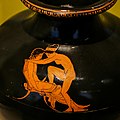

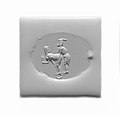

![Glass bowl fragment. The bowl had twelve images of sex on its interior and one image of sex on its exterior. Roman. End of 1st century BCE to beginning of 1st century CE[75][76]](http://upload.wikimedia.org/wikipedia/commons/thumb/d/d2/Relief_-_Glass_bowl_fragment_-_1.jpg/120px-Relief_-_Glass_bowl_fragment_-_1.jpg)







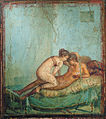
![Sex between a female and a male.The figure on the left has a garland of rose petals around their head. The figure to the right is wearing a strophium which is a kind of bra or bikini top.[79] Pompeii. Around 70CE](http://upload.wikimedia.org/wikipedia/commons/thumb/e/e5/Fragment_of_wall_painting_with_erotic_scene%2C_from_Pompeii%2C_Naples_National_Archaeological_Museum_%2817297820526%29.jpg/116px-Fragment_of_wall_painting_with_erotic_scene%2C_from_Pompeii%2C_Naples_National_Archaeological_Museum_%2817297820526%29.jpg)





